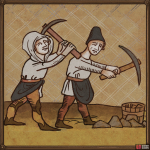Text
Silver mining in Kuttenberg (Kutná Hora) began in the late 13th century and reached its peak during the 14th and 15th centuries. Research around the town has identified 14 to 15 previously exploited vein zones.
At various times, there may have been at least 20, but more commonly 50 or even up to 200 independent mines along these zones. Around the year 1400, silver was mainly extracted in four to five mining zones, known as Oselský, Rejzský, Kuklický, Grejfský, and partially Rovenský. The landscape around Kuttenberg was thus intersected by hundreds of mining corridors and typical clearings appeared due to extensive deforesting in the area.
The first independent mine owners, and later the monarch, were unable to ensure the smooth operation of such extensive mines, so parts of them were leased for a share of the extracted ore. Approximately 20 to 30 miners worked in a single mine, while around 700 to 1200 individuals contributed to overall silver production during this period.
In addition to the miners themselves, many other workers processed the ore and performed various support tasks on the surface. This included operating and maintaining mining equipment, arranging material transport, and the work of craftsmen such as potters, charcoal burners, rope-makers and others. Each master of these trades had their assistants. Transporting people and materials to and from the mines required a large number of horse-drawn carts, stabling facilities and, of course, people to care for the animals.


No Comments